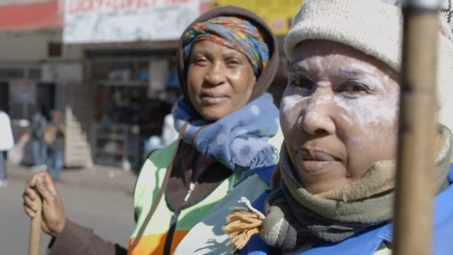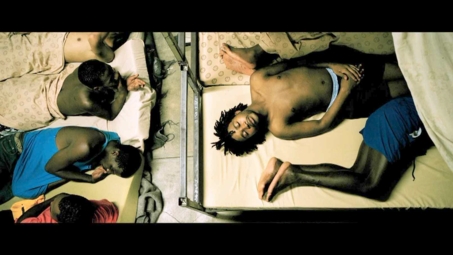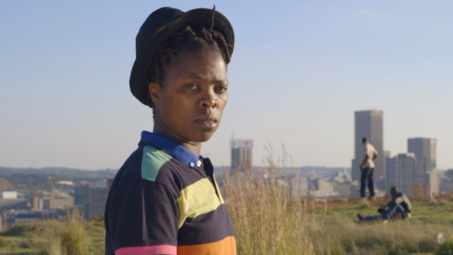Interview with avec Nathalie Masduraud and Valérie Urréa
Nathalie Masduraud and Valérie Urréa are documentary filmmakers. Beyond their personal films (on autism and dance, among others, for Valérie, and on the occupation and the French colonies for Nathalie), they join forces to produce many societal and historical documentaries.
They have thus worked in particular on Iranian and South African photography. Their joint projects generally focus on the artistic and social recognition of women.
Together they produced the Chromatic Existences series. They explain how it came about and the adventure it represented, through meeting South African photographers.
***
Emmanuel Bacquet: Hello! You produced the series of films entitled Chromatic Existences, presented on the The Darkroom Rumour throughout spring. Could you tell us what was behind this series?
Valérie Urréa & Nathalie Masduraud: It all began at the Rencontres photographiques d'Arles in 2006: one exhibition was presenting the magnificent work of David Goldblatt. This discovery came as a shock! David featured "another" history of apartheid, far from the journalistic clichés that accompanied our adolescence at the time. We quickly had the idea of doing a portrait of this exceptional photographer. But the project quickly evolved. In the end, we made a documentary for Arte, South Africa, Chromatic Existences, showing the contemporary history of this land through the lens of one of its greatest documentary photographers. From our meeting with David Goldblatt, not to mention the historical members of the Afrapix collective (an independent agency founded, at the time, on the model of Magnum), the film advanced like this, from 1976 to the present day, following the chronology of major political events. We meet a whole unique historical scene but also a new generation of photographers, heirs to the values of this "Struggle Photography" so peculiar to South Africa. From yesterday's political militancy to today's visual activism, South Africa, Chromatic Existences is therefore a historical film, but also a more in-depth reflection on the power of the image.
But parallel to this work, we also had to produce a web series to accompany this documentary. Indeed, during our scouting, it was clear that South Africa was experiencing new apartheids. What were they? While digging, we came across photographic works that remarkably document the transformation of this society. And it seemed important to us to talk about it. This is how Chromatic Society was born, bringing together different visions of contemporary photographers on very specific societal themes such as: the city, violence, the question of race, and new territories.
EB: A fight that sometimes goes beyond purely South African apartheids: Zanele Muholi is also engaged in a reflection on gender that goes beyond the territory of South Africa.
VU & NM: Yes, it's true. In documenting their community and the violence it endures, Zanele Muholi is portraying these new apartheids in a certain way. Who owns the bodies? In whose jurisdiction…? etc. Their hard-hitting work constantly challenges the dominant ideologies and representations that a society constructs. They are one of the heirs to the Goldblatt generation and a self-styled "visual activist". In fact they were David's pupil.
EB: Literally speaking?
VU & NM: Absolutely. In the late 80s, Goldblatt had set up a photography school in Johannesburg. A space designed to accommodate disadvantaged young people from the townships, blacks who were not accepted in any other art school. It was in this school that Zanele started. They say today that photography saved their life, in a country that has seen a record number of lesophobic crimes. Zanele had a very deep relationship with David; he accompanied them like a father, a mentor. And he helped them "arm themself" to fight against racism and homophobia. For several years, Zanele has been building a visual history of Black LGBTQIA communities absent from the South African media landscape.
David's school, the Market Photo Workshop, is still operating in Johannesburg and produces very interesting photographers, visually accomplished and also politically committed.
Thandile Zwelibanzi, who can be seen in the Inner City episode, also attended this school. As did Jodi Bieber, who we follow in the film Soweto.
EB: Is the South African puzzle (to which the word "chromatic" refers) so many dabs of colour that make a whole?
VU & NM: It's both a reference to light and to photography, but also to this country, which has been called the "rainbow nation": It seemed to us the right word to describe what these photographers and this nation were aiming for: to live together through a plurality of shades, in skin colour, in social circles... a country made from all these differences.
When we present Zanele Muholi and Pieter Hugo side by side in Look at Me, what's interesting is not necessarily in the contrast, in the difference between the white man and the black woman but more in what unites them. Because basically these two artists complement each other and talk about the same thing.
Jodi Bieber is a white woman who went through the hardest, most difficult times at the end of apartheid in the 90s. At the time, she had the courage to go and photograph very hard, violent things at that time. In fact, she had to leave the country for several years to rebuild herself. On her return to South Africa, she began to work on more peaceful subjects.
Her images of Soweto are a work of both resilience and discovery. She visits these places and offers us a vision that's the opposite of what you might expect. There is life, colour, and lots of movement; These photographs are meeting places. This may be the future of South Africa.
In the film that brings together David Goldblatt and Mikhael Subotzky, what is interesting is that here we bring together two generations through two different photographic expressions. With Mikhael Subotzky, it's a photography that uses staging, collage, intervention on the print. With David Goldblatt it's another way of storytelling, through texts and explanatory cards: two generations of photographers who work differently and who meet here.
Did Mikhael Subotzky distance himself from the violence he encountered? It's an interesting question when you look at his work. It undoubtedly led him more towards artistic work, using photography beyond its documentary dimension.
As for David Goldblatt, it's always this fundamentally human, empathetic approach: he spends a lot of time with his subjects, long before photographing them. When he photographs someone at the camera lucida, remember that he never looks in the viewfinder, but directly at the person in front of him, eye to eye. He doesn't cheat. He will try to show things with the heart. And in this so-violent South Africa, he will look for whatever can reconcile and allow them to carry on together.
Then there's Guy Tillim and Thandile Zwelibanzi, reunited in the film Inner City. The two come together around the history of apartheid in Johannesburg.
When we say apartheid, we're talking about geographical separation. What interested us in bringing them together was showing the geography of this apartheid. Both will go and photograph a Johannesburg that has suffered from segregation. Since then, these neighbourhoods have been repopulated. They once belonged to whites, then the blacks reclaimed these spaces.
With these two photographers, there's also the question of "how will we rebuild" from the ashes? How are we going to reclaim the city? With Guy Tillim we see gangs moving into these places in transition. And with Thandile it's something very current, a new economy, people learning to live together, but still with this apartheid that carries on underneath.
In the end, what is striking is that all these photographers made the choice to stay in their country to work. In a way, they keep hoping.
EB: Do you have any other current projects, or photographic projects?
VU & NM: After these films on South Africa, we produced a film for Arte on Iran, the meeting of five photographers: four women and one man. Focus Iran. We were able to visit this extraordinary country through their eyes. Photography occupies a special place in this country's history. And many women have taken up the camera. It was also the way to show how, in such a non-libertarian country, we can continue to express ourselves through photography.
Alongside this documentary, we also produced a series entitled Iran No Filter, which was about ten young photographers documenting Iranian society.
...And right now we're finishing a film on the first fiction director in the world, Alice Guy, as well as a series of short fiction films inspired by real events, on violence against women, which will come out on Arte this autumn: the series will be called H24.
...But we're always hoping for new photography projects!
EB: Do you practise photography yourself?
NM: Valérie does, a little, but I don't, though I adore it!
EB: Well, after all, a documentary is also 25 photographs per second! Thank you for this interview!
Interview conducted in May 2021
Translated from French by Mark Goodwin




